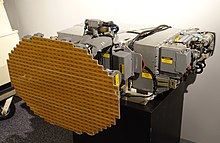AN/APG-68
 | |
| Country of origin | USA |
|---|---|
| Type | Pulse-doppler airborne radar |
| Frequency | Starting Envelope frequency around 9.86 GHz |
| Range | 296.32 km (184.12 mi) |
| Azimuth | ±10 degrees / ± 30 degrees / ± 60 degrees |
The AN/APG-68 radar is a long range (up to 296 kilometres [184 mi])[1] Pulse-doppler radar designed by Westinghouse (now Northrop Grumman) to replace AN/APG-66 radar in the F-16 Fighting Falcon. After years of Service, AN/APG-68 radar currently being replaced on US Air Force F-16C/D Block 40/42 and 50/52 by the latest generation AN/APG-83 AESA radar.[2][3]
The AN/APG-68(V)8 and earlier radar system consists of the following line-replaceable units:
- Antenna
- Dual Mode Transmitter (DMT)
- Modular Low-power radio frequency (MLPRF)
- Programmable signal processor (PSP)
The AN/APG-68(V)9[4] radar system consists of the following line-replaceable units:
- Antenna
- Medium Duty Transmitter (MDT)
- Modular Receiver/Exciter (MoRE)
- Common Radar Processor (CoRP)
The AN/APG-68(V)9 radar is the latest development. Besides the increase in scan range compared to the previous version, it has a Synthetic aperture radar (SAR) capability.
The APG-68(V)9 has equipped several variants, including the Egyptian Air Force,[5] Israeli Air Force,[6] Chilean Air Force, Republic of Singapore Air Force,[7] Turkish Air Force,[8] Royal Moroccan Air Force,[9] Greek Air Force,[10] Pakistan Air Force, Polish Air Force,[11] Royal Thai Air Force,[12] and Indonesian Air Force.[13]
Specifications[edit]
- Frequency: Starting Envelope frequency around 9.86 GHz.
- Under AIS Testing as high as 26 GHz
- Range: 296.32 kilometres (184.12 mi)
- Search cone: 120 degrees × 120 degrees
- Azimuth angular coverage: ±10 degrees / ± 30 degrees / ± 60 degrees
- Programmable Signal Processor (PSP) - The core radar component which is responsible for signal processing, frequency selection, signal digitization for B-Scope display. The PSP is controlled through the F-16 Heads Down Display Set (HDDS) or what is commonly called the Multi-Function Displays (MFDs). The PSP is directed by the system operational flight program (OFP), which is controlled and modified for new threats or addition radar system requirements. The PSP also contains all the controls circuitry for radar A/A and A/G operational scan patterns and SAR/ISAR operation.
- Modular Low Powered Radio Frequency (MLPRF) - The frequency generator for the radar system. Frequency generation is dependent on the random frequency selection from the radar tables within the PSP upon system start-up. The MLPRF will generate a small amount of RF Drive, which is sent to the Dual Mode Transmitter (DMT), where it is amplified and a small RF sample is sent to the MLPRF for comparison checksum (more like a check and balance system). The MLPRF also is responsible for the receiving of the radar return, generating the RF injection noise (for RF discrimination), and the processed RF within the MLPRF is then later sent to the PSP for video processing and threat/target matching against the radar threat tables within the PSP, prior to flightcrew system display.
- Dual Mode Transmitter (DMT) - A 24,000 volt radar transmitter, containing a TWT, which generates the amplified RF to be sent to the radar Antenna for system emission. The TWT operates by optical pulses received from the DMT's internal Pulse Decker Unit and TWT Cathode/Anode voltage inputs.
- Antenna - A planar array antenna, which is constructed to receive RF data through a waveguide system. The transmitted and received pulses are controlled in time by the PMW (Pulse Modulated Wave) radar design, and the waveguide duplexer assembly. Internal to the antenna are Uniphaser Assemblies (used for quadrature phase control), Phase Shifters (used of quadrature I/Q data) and gimbalized motor control for antenna positioning and position correction.
References[edit]
- ^ "Ancile".
- ^ Hunter, Jamie (4 March 2022). "USAF launches huge upgrade program for its F-16s". Skies Magazine. Archived from the original on 25 September 2022. Retrieved 25 September 2022.
- ^ Leone, Dario. "USAF to Upgrade 608 F-16 fighter jets to V variant in Viper Fleet largest Modification Work in History". The Aviation Geek Club. Archived from the original on 25 September 2022. Retrieved 25 September 2022.
- ^ "Archived copy" (PDF). Archived from the original (PDF) on 2011-05-26. Retrieved 2011-05-24.
{{cite web}}: CS1 maint: archived copy as title (link) - ^ "Egypt to receive 24 F16 in $3.2bn deal". defenceWeb. 2009-10-19. Retrieved 2021-03-27.
- ^ admin (2004-01-21). "APG-68(V)9 Radar for Block 50/52 F-16". Defense Update. Retrieved 2021-03-27.
- ^ "Home - DDTC Public Portal" (PDF). www.pmddtc.state.gov. Retrieved 2021-03-27.
- ^ "Turkey completes deal for 30 new F-16s". www.flightglobal.com. Archived from the original on 2009-02-28.
- ^ "Morocco - F-16C/D Block 50/52 Aircraft". www.defense-aerospace.com. Retrieved 2021-03-27.
- ^ "Performance Flight-Testing Of Updated Radar Under Way For Lockheed Martin F-16". www.defense-aerospace.com. Retrieved 2021-03-27.[permanent dead link]
- ^ "Military Technology 9/2019". www.monch.com. Retrieved 2021-03-27.[permanent dead link]
- ^ "Northrop Grumman to Supply Airborne Fire Control Radars to Thailand, Iraq and Oman for F-16s". Northrop Grumman Newsroom. Retrieved 2021-03-27.
- ^ "Bopong Senjata dan Radar Canggih, Pesawat F-16 TNI AU Semakin Garang". SINDOnews.com (in Indonesian). 2020-08-28. Retrieved 2021-08-10.
